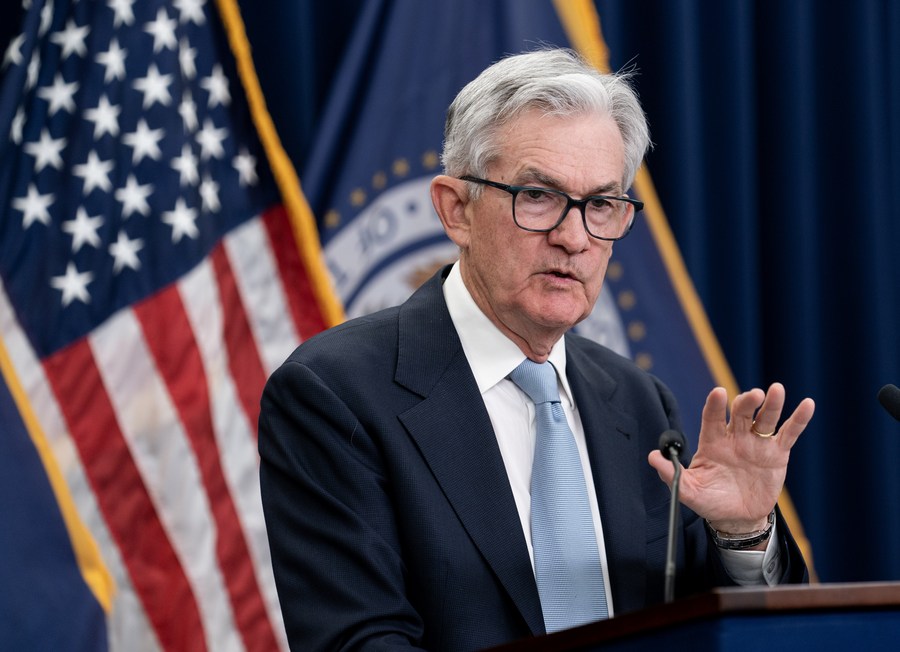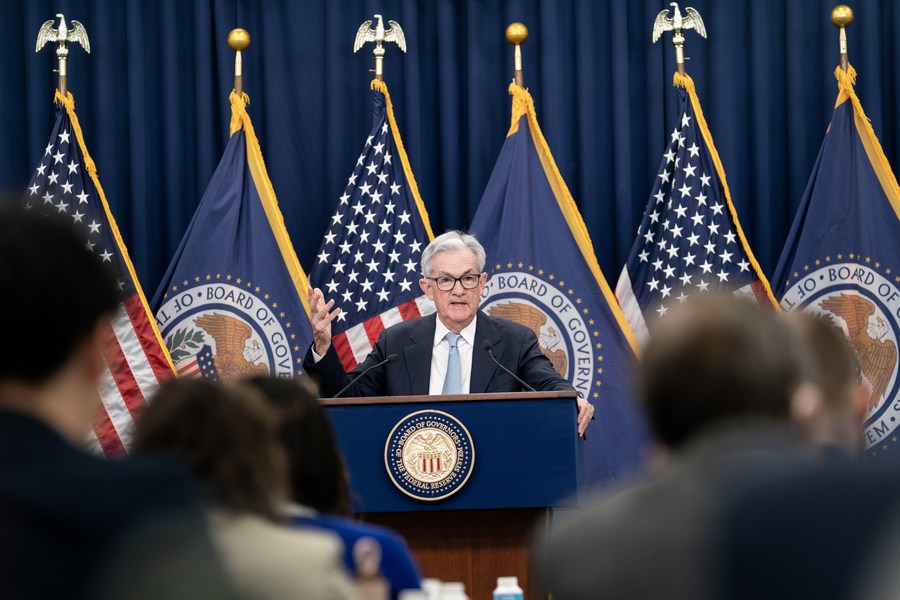Dow sinks 530 points after Fed rate hike

U.S. Federal Reserve Chair Jerome Powell attends a press conference in Washington, D.C., the United States, on March 22, 2023. (Xinhua/Liu Jie)
Fed Chair Jerome Powell said the rate-setting committee considered a pause in rate hikes in light of the banking crisis. Yet stubbornly high inflation and a strengthening labor market in early 2023 ultimately persuaded Fed officials they needed to raise rates again, he said.
NEW YORK, March 22 (Xinhua) -- U.S. stocks fell sharply on Wednesday after the Federal Reserve raised rates by a quarter of a percentage point.
The Dow Jones Industrial Average fell 530.49 points, or 1.63 percent, to 32,030.11. The S&P 500 dropped 65.90 points, or 1.65 percent, to 3,936.97. The Nasdaq Composite Index shed 190.15 points, or 1.60 percent, to 11,669.96.
All the 11 primary S&P 500 sectors ended in red, with real estate and financials down 3.64 percent and 2.37 percent, respectively, leading the slide.
The Fed approved a 25 basis point rate hike at the conclusion of its two-day meeting on Wednesday, forging ahead with its fight against stubborn inflation despite financial turmoil following Silicon Valley Bank's collapse.
It marked the ninth consecutive rate increase and the latest move brought the target range of the federal funds rate to 4.75 to 5 percent, the highest since 2007.
In a post-meeting statement, the Fed said that inflation remains elevated and that the central bank remains "highly attentive to inflation risks," while banking issues could cause credit conditions to tighten and weigh on economic growth.
"The U.S. banking system is sound and resilient," the Fed said in the statement. "Recent developments are likely to result in tighter credit conditions for households and businesses and to weigh on economic activity, hiring and inflation. The extent of these effects is uncertain."
The Fed's updated economic projections published on Wednesday showed that officials anticipated another quarter-point increase to a peak range of 5 to 5.25 percent, in line with the December estimate.
"Policymakers face a tricky choice at today's rate-setting meeting, with the need to balance worries over the banking system with continued high inflation," said UBS analysts.

U.S. Federal Reserve Chair Jerome Powell (Rear) attends a press conference in Washington, D.C., the United States, on March 22, 2023. (Xinhua/Liu Jie)
In his press conference on Wednesday, Fed Chair Jerome Powell said the rate-setting committee considered a pause in rate hikes in light of the banking crisis.
Yet stubbornly high inflation and a strengthening labor market in early 2023 ultimately persuaded Fed officials they needed to raise rates again, he said.
The Fed's latest forecast signaled the personal consumption expenditures inflation, the Fed's preferred price barometer, will ease to 3.3 percent by year end, up from its prior estimate of 3.1 percent.
Meanwhile, Powell noted that tighter credit conditions are likely ahead following recent banking turmoil, adding the central bank will closely monitor incoming data and assess the actual and expected effects on tighter credit conditions on economic activity, the labor market and inflation in order to inform its policy decisions.
Earlier this month, U.S. regulators closed Silicon Valley Bank after the tech-focused lender reported massive losses from securities sales, triggering a run on the bank's deposits.
It marked the second-largest bank failure in U.S. history and was quickly followed by the collapse of cryptocurrency sector lender Signature Bank.
The bank failures raised concerns over the health of the U.S. banking system, and analysts noted that the recent U.S. bank turmoil is a reminder that Fed hikes are having consequences.
Photos
Related Stories
Copyright © 2023 People's Daily Online. All Rights Reserved.









